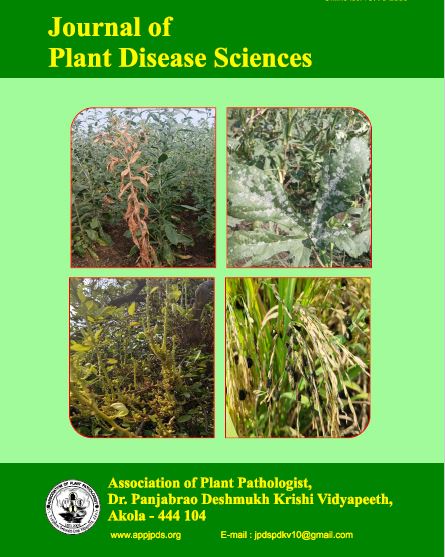DETECTION OF SEED BORNE MYCOFLORA OF SOYBEAN
DOI:
https://doi.org/10.48165/jpds.2025.20.01.13Keywords:
Detection, Mycoflora, Seed borne, SoybeanAbstract
Soybean is one of the most valuable legume crops globally and an excellent source of vegetable oil. However, its productivity is significantly affected by seed-borne pathogens that contribute to yield reduction. In the present study, seed samples of five soybean cultivars—JS-335, MAUS-162, AMS-1001, AMS-MB-5-18, and MAUS-71—were collected and evaluated for seed-borne mycoflora using the standard blotter paper method, standard agar plate method, and rolled paper towel method as per ISTA guidelines. A total of nine seed-borne fungi, including both saprophytic and parasitic species, were identified: Alternaria alternata, Rhizoctonia bataticola, Curvularia lunata, Fusarium solani, Cladosporium cladosporioides, Drechslera rostrata, Aspergillus niger, Aspergillus flavus, and Rhizopus stolonifer. Among the detection methods, the standard blotter method recorded the highest frequency of fungal occurrence, with Fusarium solani being the most dominant (25.25%), followed by A. flavus (16.75%), A. niger (13.27%), D. rostrata (4.90%), and others in decreasing order. R. bataticola was predominantly detected using the agar plate method, showing 18.35% frequency. These findings emphasize the importance of seed health testing and fungal detection methods for effective disease management in soybean cultivation.
References
Anonymous, 2022: Soybean Outlook, March 2022. Agricultural Market Intelligence Centre, PJTSAU.
Aglave, H. R., 2016: Seed borne fungi of soybean. Anveshana International Journal of Research in Pharmacy and Life Sciences, 1(1): 88–92.
Ahmad, S. K., Anandam, R. J., Babu, G. P., Munikrishnaiah, M., & Gopal, K., 2006: Studies on seed mycoflora of soybean and its effect on seed and seedling quality characters. Legume Research, 29(3): 186–190.
Barnatt, H. L. & Hunter, B. B., 2003: Illustrated Genera of Imperfect Fungi. Fourth edition, APS Press, St. Paul, Minnesota.
Ramesh, B. V., Hiremath, S. V., Naik, M. K., Amaresh, Y. S., Lokesh, B. K., & Vasudevan, S. N., 2013: Study of seed mycoflora of soybean from northeastern Karnataka. Karnataka Journal of Agricultural Sciences, 26(1).
Safdar, A. A., Riaz, S., Ahmad, C. A., Subhani, M. N., & Chattha, M. B., 2013: Mycoflora associated with stored seeds of soybean. Mycopath, 11(2): 85–90.
Shovan, L. R., Bhuiyan, M. K. A., Sultana, N., Begum, J. A., & Pervez, Z., 2008: Prevalence of fungi associated with soybean seeds and pathogenicity tests of the major seed-borne pathogens. International Journal of Sustainable Crop Production, 3(4): 24–33.

